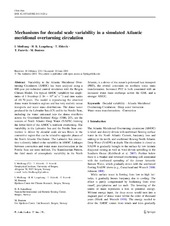| dc.contributor.author | Medhaug, Iselin | eng |
| dc.contributor.author | Langehaug, Helene Reinertsen | eng |
| dc.contributor.author | Eldevik, Tor | eng |
| dc.contributor.author | Furevik, Tore | eng |
| dc.contributor.author | Bentsen, Mats | eng |
| dc.date.accessioned | 2013-04-29T10:51:48Z | |
| dc.date.available | 2013-04-29T10:51:48Z | |
| dc.date.issued | 2011-06-25 | eng |
| dc.Published | Climate Dynamics 39(1-2): 77-93 | eng |
| dc.identifier.issn | 0930-7575 | en_US |
| dc.identifier.uri | https://hdl.handle.net/1956/6537 | |
| dc.description.abstract | Variability in the Atlantic Meridional Overturning Circulation (AMOC) has been analysed using a 600-year pre-industrial control simulation with the Bergen Climate Model. The typical AMOC variability has amplitudes of 1 Sverdrup (1 Sv = 106 m3 s-1) and time scales of 40–70 years. The model is reproducing the observed dense water formation regions and has very realistic ocean transports and water mass distributions. The dense water produced in the Labrador Sea (1/3) and in the Nordic Seas, including the water entrained into the dense overflows across the Greenland-Scotland Ridge (GSR; 2/3), are the sources of North Atlantic Deep Water (NADW) forming the lower limb of the AMOC’s northern overturning. The variability in the Labrador Sea and the Nordic Seas convection is driven by decadal scale air-sea fluxes in the convective region that can be related to opposite phases of the North Atlantic Oscillation. The Labrador Sea convection is directly linked to the variability in AMOC. Linkages between convection and water mass transformation in the Nordic Seas are more indirect. The Scandinavian Pattern, the third mode of atmospheric variability in the North Atlantic, is a driver of the ocean’s poleward heat transport (PHT), the overall constraint on northern water mass transformation. Increased PHT is both associated with an increased water mass exchange across the GSR, and a stronger AMOC. | en_US |
| dc.language.iso | eng | eng |
| dc.publisher | Springer Verlag | en_US |
| dc.rights | Attribution CC BY | eng |
| dc.rights.uri | http://creativecommons.org/licenses/by/2.0/ | eng |
| dc.subject | Atlantic Meridional Overturning Circulation | eng |
| dc.subject | Deep water formation | eng |
| dc.subject | Water mass transformation | eng |
| dc.title | Mechanisms for decadal scale variability in a simulated Atlantic Meridional Overturning Circulation | en_US |
| dc.type | Peer reviewed | |
| dc.type | Journal article | |
| dc.description.version | publishedVersion | en_US |
| dc.rights.holder | Copyright the authors | en_US |
| dc.identifier.doi | https://doi.org/10.1007/s00382-011-1124-z | |
| dc.identifier.cristin | 825921 | |
| dc.source.journal | Climate Dynamics | |
| dc.source.40 | 39 | |
| dc.source.14 | 1-2 | |
| dc.source.pagenumber | 77-93 | |

